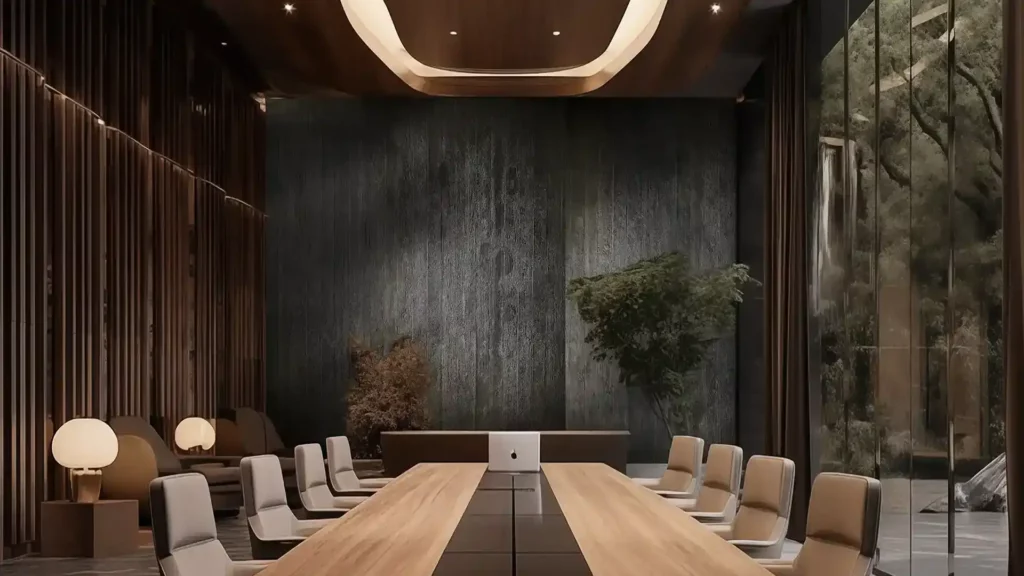
Yakisugi (Burnt wood): its elegance and advantages
XSTONE Yakisugi
The XSTONE range of burnt planks is an elegant, flawless and easy-to-install solution for achieving the unmistakable Japanese Yakisugi style in commercial or domestic spaces. Unlike the original, no fire is used, respecting environmental constraints, and more resistant over time by using materials and a finishing process creating a burnt appearance and the natural texture of wood. The final aesthetic result is identical to the Yakisugi.

The rise of Yakisugi
Yakisugi has recently enjoyed a resurgence in popularity. This ancient Japanese technique has been rediscovered and reinvented to produce magnificent decors, even if the modern interpretation is a far cry from the practical intentions behind the technique. Although it produces a beautiful aesthetic, Yakisugi can have certain disadvantages. We’re going to explore some of these disadvantages and how they can be resolved so that you can have the incomparable design of Yakisugi without the disadvantages.
What is Yakisugi?
Originating in 18th century Japan, Yakisugi is a method of preserving wood by charring it with fire. Traditionally, this practice is used with Japanese cedar to protect it from the elements. The wood is burnt until the surface is charred, then coated with natural oil. The result is a burnt finish with a magnificent anthracite black colour. The surface of the wood can take on the appearance of cracked skin or scales, depending on the species of wood and the intensity of the burning. Traditionalists only use Japanese cedar because it withstands the heat better and burns more deeply, making it resistant to insects, mould and, surprisingly, fire. The wood becomes waterproof and UV-resistant.

Interest in Yakisugi, particularly in the West, has led many people to try the method on various types of wood. However, deep burning often does not give good results on other types of wood, and the charred top layer erodes easily, leaving a degraded appearance while at the same time removing the wood’s protective, fire-retardant and weather-resistant properties. Yakisugi is both artisanal and original, a bit like reclaimed wood. For a company or designer looking for these qualities, Yakisugi is particularly attractive, because it gives that authentic effect. The carbonisation technique gives it a raw, natural character. The Yakisugi process involves charring the wood, cooling it, cleaning it by brushing and washing, and then protecting the wood with oil. Some people burn each plank of wood with a torch, but the traditional method involves grouping three planks together in triangular tubes and burning the inside. With the traditional method, different aspects are obtained not by varying the burning process but by various brushing methods. Furnaces are now used for large-scale production. If traditional methods and original wood species are not used, there may be problems with product longevity and wood stability.
The disadvantages of Yakisugi
The original appearance of wood treated with the Yakisugi method is incomparable, but there are some risks and difficulties due to the process and the product itself. Firstly, there are practical difficulties. The surface of the wood can crumble and soil floors, surfaces and clothes, which can create a mess if not checked before installation and once the room is occupied. This charcoal dust can spread throughout a building and even be inspired by the people living in the space decorated with real Yakisugi burnt wood.
It should also be noted that traditionalists warn that Yakisugi is not a method that can be applied to just any type of wood. Japanese cedar, the ideal wood for Yakisugi, reacts to heat in a unique way, unlike other woods. So, if you’re looking for the protective benefits of Yakisugi, there are few species other than Japanese cedar that are suitable. Although the burnt wood method can technically be used on any wood, the effect is not the same, making it difficult to achieve an elegant and durable design.
Modernised Yakisugi also loses its liveliness over time, creating a patina that may not be the effect originally intended for its decoration. This limited durability means that a surface decorated with Yakisugi wood will need to be regularly refinished or part of the wood replaced to retain its original appearance. Therein lies the problem – architects and decorators want the beauty of Yakisugi without the inconvenience and consequences.
The solution: Yakisugi imitation
The XSTONE Yakisugi range is a solution without these disadvantages and easy to install for decorating in the Yakisugi style in commercial or private spaces. Unlike the original Yakisugi, no fire is used to create the burnt wood effect; instead, we use a copolymer-based manufacturing process and finish to create a burnt wood look. The end result is exactly the same as the original Yakisugi.
XSTONE Yakisugi has a number of advantages over its traditional counterpart. The surface will not chip or fall to dust on the floor or clothing. Nor will it require maintenance or replacement once the surface has crumbled or lost its beauty. The reinforced protection used preserves the shine of the finish and improves its durability. In addition, appropriate finishes are used for both interior and exterior applications to ensure optimum performance in all situations.
Thanks to the care taken in the manufacture of XStone Yakisugi, even the most demanding architects and decorators won’t be able to distinguish it from the original. The many reactions on discovering XStone Yakisugi show that everyone initially thinks it’s genuine Yakisugi burnt wood planks, and that’s exactly what we were aiming for; a magnificent product that honours the authentic Yakisugi while avoiding any health problems or drawbacks.
We specifically focused on well-being and health with this product. Well-being and health are key elements of the building environment, and the construction materials used must therefore be beneficial to the occupants. We believe that everyone should have access to the unparalleled beauty of Yakisugi without its drawbacks, and it is this vision that inspired the creation of XStone Yakisugi.
In conclusion
Yakisugi is undoubtedly one of the most beautiful traditional wood treatment methods, but its drawbacks can make it less desirable. Fortunately, our XStone Yakisugi solution faithfully recreates the striking design of Yakisugi, using low-VOC materials to offer a wellness-focused product that is rot-proof and fire-resistant. It is our tribute to a timeless Japanese technique that deserves greater recognition from the design and decoration industry.
